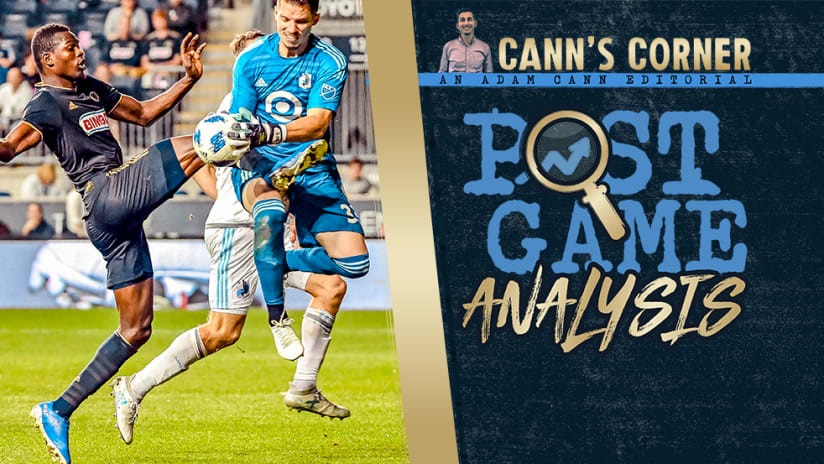The Union have an identity now.
Sometimes it’s hard to tell what a team wants to be, or how they want to play in a match against a far inferior opponent. Perhaps Minnesota United is not always as poor as they were on Saturday night, but the visitors’ bland showing provided the clearest window yet into what Philadelphia Union have become since March.
Recall that at the start of the season, the plan was to use Fafa Picault on the right so David Accam could patrol the left side of the pitch. Accam’s difficult season meant that Picault ended up on the left, with a rotating cast of Ilsinho, Fabian Herbers, and Marcus Epps on the right, all of whom eventually gave way to CJ Sapong. During that mix-and-match period, it became clear that Alejandro Bedoya’s versatility and history as a player that could hang on the wing or roll through the middle meant he was very comfortable operating in the right channel.
Jim Curtin could have rebelled against this unbalanced look and sought ways to unravel it and make his team more two-sided. Instead, the head coach embraced it. Since that point, Bedoya’s ability to create extra man situations on the right — and Borek Dockal’s ability to see them — has meant that the Union run rampant on anybody unwilling to adjust defensively and try to squeeze them off the right.
When Minnesota sat back in two banks of four Saturday night, then, they were always asking for trouble. And when Adrian Heath’s attackers didn’t drop to help defensively… yeah, it was not good.
The right to roll
Four key passes and two assists came off the right in the first half alone for Philly. Another assist came when the right back zipped into the center and drew a foul. By dominating the right half of the central third of the pitch, the Union accomplished two things: First, they drew one central midfielder over to the wing, which meant space in the center while Philly retained a numerical advantage on the right. Second, they did most of their connecting far enough from the Minnesota goal that when they were turned over there was not a huge swath of space for the Loons to accelerate into as they looked to counter.
The match, then, was played entirely on the Union’s terms from the outset, and Adrian Heath never really had a chance to use Jerome Thiessen in the attacking half on his own right flank. This is key because part of Heath’s plan was to allow his right fullback to push high and become an extra man in attack, essentially forcing Fafa Picault to play defense as a method of controlling his attacking abilities. You can see from the outset that Thiessen is prepared to bomb up the right, but since the Union midfield was able to bypass Minnesota in the center so easily, and as a result the Loons back line dropped extremely deep extremely fast, Thiessen quickly became a liability.
The decision to shift Miguel Ibarra into the back line in the second half made sense in that Ibarra is primarily an attacker rather than a defender, so the rest of the back line didn’t rely on him to cover Picault and were quicker to shift across.
Putting on a press
Minnesota is bad at defense, yes. But this has not made them particularly easy to pass through in 2018. Prior to last Saturday, they had given up the second fewest goals of any team in the west below the playoff line, and had even allowed fewer than Toronto FC.
What handed the Union an advantage on Saturday was their ability to turn Minnesota over quickly and repeatedly with organized pressing, so even when Philly didn’t finish a chance, they came right back down the Loons’ throat a moment later. Below, you can see an example of the Union’s zonal press closing high on Minnesota, with Bedoya then dropping centrally to help collect second balls.
And next, you can see Fafa Picault absolutely putting in work, pressing all over the pitch until he almost single-handedly forces a turnover. In all the praise for Picault’s attacking production, let us not forget that the winger cannot be taken off the pitch specifically because of the defensive work he puts in.
Speedy restarts
An exceedingly simple but consistently effective tactic the Union have employed all season is the quick restart. Throw-ins, free kicks, corners, it doesn’t matter: If Philly sees a team slow to organize, they attempt to capitalize. On Saturday, both Cory Burke and Fafa Picault scored after intelligent, fast restarts caught Minnesota napping.
First, here is the full sequence leading up to Burke’s tally, starting with Keegan Rosenberry hustling to get a throw to Ale Bedoya, which leads to a disorganized defensive line against Burke, who goes Hulk on anyone in his way.
Next, Picault’s first, which is created by Haris Medunjanin’s recognition that Minnesota has a gigantic gap between their lines after fouling Rosenberry in the center. This one will be very hard for Adrian Heath to watch.
Jim Curtin has drilled quick restarts into his team (they do it in practice constantly), and the success the club has had through this simple tactic is impressive. Think back to Ilsinho’s super goal against Chicago at home — it started when Rosenberry quickly got a throw-in to Borek Dockal, finally providing the creator with enough time free from his marker to play Ilsinho into space.
Philly’s win over Minnesota was comprehensive, but there is still a lot of work to do. A home playoff match is within reach, but it’s an uphill battle against two (of only three) teams above the Union in the standings. Beating Red Bull would silence the last doubters of 2018, so let’s see what Curtin and the Union have in store on October 21.












